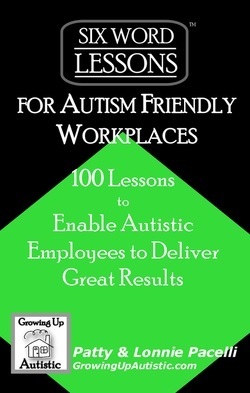Lonnie Pacelli's Blog, page 87
December 13, 2013
My Life as a box of Chocolates
My son Trevor wrote about his first semester experiences at Arizona State University and beautifully articulates how he's faced challenges and how growing up autistic has made some things more challenging but not at al insurmountable. Straight from the heart and very well done. Read it here.
Published on December 13, 2013 15:55
December 7, 2013
How Could This Happen? Avoid Project Screw-Ups for You and Your Business Partner
 Project screw-ups mean wasted time and money and can irreparably damage your relationship with business partners if they perceive that you are at fault—in any way. If you’ve been through a post-mortem for a project that failed, you’ve likely heard one or more of these “we didn’t” excuses:
Project screw-ups mean wasted time and money and can irreparably damage your relationship with business partners if they perceive that you are at fault—in any way. If you’ve been through a post-mortem for a project that failed, you’ve likely heard one or more of these “we didn’t” excuses:“We didn’t define the problem we were trying to solve.”
“We didn’t communicate what we were doing.”
“We didn’t manage our project risks and issues.”
“We didn’t create a good project plan.”
“We didn’t have the right sponsorship.”
“We didn’t work well together.”
Having a business partner remember you as “that $%@*# project manager” because you were associated with a project failure is one of the worst things that can happen to a project manager. Not only will you have lost the trust of the business partner, but your ability to win the trust of other business partners could be in jeopardy because of the negative reputation you may have earned.
While this is a very real risk, you can take steps to avoid that fate. Follow these six tangible principles to avert those project screw-ups and stay on the road to success:
Amazon.com Widgets Get laser focused on the mission. This may sound like a “duh,” but I’ve been amazed at the number of projects I’ve seen (and participated in) where someone halfway into the project asked, “Now what are we trying to do again?”
Focus on what needs to be done, when it needs to be finished, and the measures which will be used to determine success. Making a statement such as, “We need to reduce costs,” is too vague and isn’t enough for a project team to get passionate about.
A statement such as, “We need to reduce the cost of processing invoices by 50 percent by September 1st while ensuring that vendors are paid within terms 100 percent of the time,” specifies the mission.
Be specific about the project schedule. Key to any successful project is a well-engineered schedule. Depending on the project, the plan could be a simple task list or it could be a complex project plan with many dependencies and critical paths which change frequently as the project progresses.
Spend the time up front to plan out the work in a very clear and concise manner. Break down tasks to a point where a single owner can be identified as responsible and the duration for the task is 40 work hours or less.
Clearly understand your critical path through the project by determining task dependencies. Ensure assignments are clear so that each team member knows specifically what needs to be done, when it has to be done by, and what happens if a task isn’t completed on time.
A weak project plan is like building a house on a foundation of sand; you’ll make some early progress, but the building will fall down.
Make sure you have clear, committed sponsorship. For any project, it’s crucial to get an appropriate level of project sponsorship. The ideal project sponsor:
Experiences the pain of the status quo and would directly benefit from a successful project.
Actively helped craft the project mission statement.
Has the decision making authority to secure or re-allocate resources to or from other projects to ensure that your project can be completed successfully.
Goes to bat for your project with peer managers if you need help getting something from another organization.
Meets with you on a regular basis to ensure that you’re getting what you need to succeed.
Makes difficult decisions that may be unpopular but are in the best interests of the business.
If your sponsor doesn’t demonstrate the above characteristics, proceed with caution. Apathetic or nonexistent sponsorship can spell a slow, lingering death for your project.
Put a team in place that will gel. A well structured project team on which each member understands his or her role in making the project successful is like listening to a fine orchestra.
Team members understand what they need to do to make the project successful and operate first and foremost for the good of the team versus individual gain. Get clear on roles, hold team members accountable for delivery, praise those members who help others on the team, and avoid showing any bias to a particular team member or group.
Develop clear, concise, and regular stakeholder communication. Many groups can be affected by the result of a project, including the project team, executive sponsor, steering committee, customers, and other interested parties. These are all audiences that should be included in your communications plan.
Once you define your stakeholder groups, determine the frequency, medium, and content appropriate for each segment. Don’t assume a one-size-fits-all communication for your stakeholders. What may work for one group might be a waste for another. Keep your communications relevant to your stakeholders so they will pay attention to what you send out.
Manage project risks and issues. Your project is humming along and stuff is getting done. Then, out of the blue, an unanticipated issue comes up. As the project manager, you determine that the issue won’t have an impact on the schedule, and you let the one of the project team members work it out.
But the issue doesn’t go away because the project team member thinks the project manager is driving issue resolution. Before you know it, the project is late because the design issue wasn’t addressed when it should have been.
For project risks, ensure you have a clear articulation of each major risk your project faces, a mitigation plan for each risk, and a team member assigned to monitor the risk throughout the life of the project. For project issues, ensure you have a clear understanding of each one as soon as it rears its ugly head and that you are able to actively monitor the issue through its resolution. Don’t sweep the risk or issue under the carpet hoping it will go away, because it won’t.
Project managers need to keep a close lookout for screw-ups which can cause projects to fail and create problems for both them and their business partners. Help keep your reputation spotless as a project manager—keep these six things in mind as you’re undertaking your next business partner project.
Published on December 07, 2013 21:50
Team Building: Some Assembly Required
 Have you ever had a team that just didn’t gel? That spent more time fighting and finger pointing than getting the job done? That showed confusion as to who was doing what? If so, you’re not alone. Many managers spend precious time refereeing team members when they should be focusing on more productive and profitable endeavors.
Have you ever had a team that just didn’t gel? That spent more time fighting and finger pointing than getting the job done? That showed confusion as to who was doing what? If so, you’re not alone. Many managers spend precious time refereeing team members when they should be focusing on more productive and profitable endeavors.Why do some teams simply not get along? One reason could be that managers are seeking a certain “type” of team member, or team members just like themselves, when they should be aiming for a mix of types. For example, a toolbox with only one size or type of screwdriver would be of limited use around the house. Rather, you’d need different types of screwdrivers to tackle the various tasks. The same concept applies to the workplace. Rather than comprise your team of similar people types, you need a mix to get all the jobs done.
To illustrate the different types of personalities that make up a well-balanced team, let’s use the following Screw Squad characters. Each of these cartoon characters has something positive to offer the team, and by ensuring diversity in your team, or toolkit, the positive qualities of the other team members will balance out any negative traits. At the end of each character description you will see suggestions for the best way to use each type on your team. And while you don’t have to tell your team which Screw Squad character matches each member, you definitely should make each person accountable for a certain role, based on their inherent strength. By doing so, your team will finally gel.
Amazon.com Widgets
 D. R. Iver
D. R. IverThe first team member is D. R. Iver. You’ve probably seen this person try to take control of a meeting or project team. Some of this person’s characteristics include the ability to focus on the mission, to drive work to completion, and to hold team members accountable for deliverables. D. R. Iver is great in situations where the mission is clear and the work is well defined, when the team is in “delivery mode,” or where delivery is dependent on multiple team members completing individual tasks. On the other hand, D. R. Iver can hurt in situations where the team needs time to gel or to brainstorm ideas, or where team members are still going through learning curve.
Use D. R. Iver when:
You have to get a team mobilized to get something done.
You need structure and discipline in your execution.
You have to meet a tight deadline.
 Gloom N. Doom Gloom N. Doom is the person who always sees the glass as half-empty. These people tend to focus on why something won’t work, which can lead to them spending time worrying versus doing. Gloom N. Doom is great at providing reality checks when analyzing a solution to a problem, at testing a proposed solution prior to implementation, and when the team is unrealistic about work that can be accomplished in a given timeframe. Realize, though, that Gloom N. Doom can slow the team down when the group already has problems working together and getting motivated to perform, or when tight execution is needed without distractions. However, if you can convince Gloom N. Doom of your project’s worth, then you’re onto a winner!
Gloom N. Doom Gloom N. Doom is the person who always sees the glass as half-empty. These people tend to focus on why something won’t work, which can lead to them spending time worrying versus doing. Gloom N. Doom is great at providing reality checks when analyzing a solution to a problem, at testing a proposed solution prior to implementation, and when the team is unrealistic about work that can be accomplished in a given timeframe. Realize, though, that Gloom N. Doom can slow the team down when the group already has problems working together and getting motivated to perform, or when tight execution is needed without distractions. However, if you can convince Gloom N. Doom of your project’s worth, then you’re onto a winner!Use Gloom N. Doom when:
You need a “devil’s advocate” to test assumptions, designs, or solutions.
You want to ensure that a schedule is doable.
You want to ensure that key issues and risks are identified.
 Op T. Mystic
Op T. MysticOp T. Mystic is Gloom N. Doom’s polar opposite, always seeing the glass as half-full and taking the viewpoint of why something can work. These people can be overly optimistic in estimating task durations, which can lead to schedule slips, but Op T. Mystic is good at energizing the team and the customers, and at thinking outside the box. Be careful of Op T. Mystic’s enthusiasm where accurate assessments of risks and issues are needed or where work scope needs to be tightly managed.
Use Op T. Mystic when:
You need to energize the team with a “can-do” attitude.
You want to generate excitement with customers or business partners.
You need to instill creative thinking and execution in the team.
 Sir Prised
Sir PrisedCharging in on his trusty steed comes Sir Prised, with his battle cry of
“Was I supposed to do that today?” Sir Prised can be very creative, excelling in unstructured environments where “out of the box” thinking is required. However Sir Prised is likely to fall down when structure in execution is necessary or when the work scope needs to be tightly managed.
Use Sir Prised when: You want to instill creativity in the team.
The work is unstructured, e.g. responding to customer support requests.
You need someone to perform “possibility thinking.”
 N. Gree
N. GreeLike Gloom N. Doom, N. Gree takes the viewpoint of why something can’t possibly work, but does so in an aggressively negative manner. Teamwork and civil communication are not this person’s forte, which may be why N. Gree is great at getting management’s attention. After all, most managers take notice of aggressive behavior. While this may seem like a person you would want to avoid having on your team, even N Gree can perform a valuable function when the team needs a kick-in-the-rear to get going or when the team is being unrealistic about work that can be accomplished in a given timeframe.
Use N. Gree when: You need to get the team or management’s attention to a problem.
You don’t care what the china shop looks like after the bull has been in it.
You need a reality check. Filling Your Toolbox
So, does this mean that for a team to be well balanced, it needs to contain at least one of each Toolbox Tribe member? Of course not! The skills that each member brings to the team are more important than their personality type. Remember, you couldn’t build a rocket ship if you had one of each character on the project team, but none of them was a rocket scientist!
If possible, though, you should at least seek out one each of the first three types: D. R. Iver, Gloom N. Doom, and Op T. Mystic. However, if your team consists of all D. R. Ivers or all Op T. Mystics, that character’s negative qualities can end up dragging the whole team down. The same can happen if one person manages to dominate the team, even if it is well balanced. In these cases, the best tactic is for the team leader to take that person to one side and ask him or her to back down.
Fixing It All Together
In a well-structured team, each member knows what he or she needs to contribute, when each person has to perform, what the other team members are doing, and what it takes to be successful. Just as important, each team member helps the others to ensure the team’s overall success. After all, a team that works well together is more likely to pull together during the rough patches. In addition, having your team members in appropriate positions makes it easier for them to shift roles where needed and work outside their comfort zones. Whatever your team’s aims are, success comes more easily with a well-stocked toolkit
Published on December 07, 2013 21:50
Project Management Screw-Up 7 - We Didn't Involve The Right People
Excerpted from The Project Management Advisor - 18 Major Project Screw-Ups And How To Cut Them Off At The Pass (Prentice Hall, 2004)
 Some years back I worked on a process re-engineering project at a large industrial manufacturer. The project went on for several months and it looked as if things were going quite well. Then, a person that I’ll call “Hack” showed up on the project who reported to one of the divisional VP’s. Hack came into the project with a negative view of the project and, after spending a couple of weeks on the project, was successful in convincing the divisional VP that the project should be shut down.
Some years back I worked on a process re-engineering project at a large industrial manufacturer. The project went on for several months and it looked as if things were going quite well. Then, a person that I’ll call “Hack” showed up on the project who reported to one of the divisional VP’s. Hack came into the project with a negative view of the project and, after spending a couple of weeks on the project, was successful in convincing the divisional VP that the project should be shut down.
The project team packed up and was out of there that day. In looking at the situation, had we involved Hack earlier in the project we could have made some fundamental changes in the direction which would have put the project on a path more in line with management expectations and avoided wasting time & money on the project.
Chances are, there has been a Hack on one of your projects who showed up, disrupted everything and either slowed down or derailed your project completely. It could be that it was the wrong business decision to shut the project down, but it could also be that it was the right thing to do because the project wasn’t addressing the collective need of the customer. Regardless of right or wrong, it is very important to know who to involve in your project to better ensure success and avoid the waste and frustration of a stalled project.
Amazon.com Widgets So, let’s talk about the people, or stakeholders, who aren’t assigned to the project but can materially influence its outcome. In my experience, stakeholders generally fall into two groups: customer stakeholders, or those you help, and supplier stakeholders, or those who help you. Your customer stakeholders primarily are going to be your customer population and their associated management. At the end of the day, they are going to be the ultimate judge of your end product and will be your ultimate measure of success. Your supplier stakeholders can be quite varied. Technical support personnel, consultants, and third-party software providers are all examples of supplier stakeholders. As you design your project, you’ll need to think about the types of help that you will need and enlist support from your supplier stakeholders to help ensure success.
How it happens:
There is not clear definition on who the customer is – Getting your customer list right and making them aware of the project early on is super important in avoiding project stalls and fire drills because someone is bent out of shape because they weren’t included. Something that I’ve learned (again the hard way) is that you very well could be doing everything right on your project and that the project is being done for all the right reasons. However, if someone was not included (but should have been) in the project at the beginning and “finds out” that the project is going on, you have a situation on your hands. You not only need to orient them to the project and get their commitment, but also smooth ruffled feathers because you didn’t include them in the first place. Many times things work out OK, but you’ve taken time away from other activities to deal with a fire drill that could have been avoided had you better defined the customer list at project onset. .
Others who could help with specific issues on the project weren’t utilized – On one project that I was the business owner, an employee relatively new to the company was working on a critical project to aggregate worldwide financial planning information and report it to senior finance management. He did an outstanding job of defining the information requirements, setting up the reporting infrastructure, and managing the team members assigned to him to complete the project. He came up against a project issue and was working hours on end trying to get the issue resolved among the project team. When he raised the issue to me, I asked him if he had contacted the group in the company that had expertise on the very issue he was trying to solve on his own. End of the story is that he solicited help from the group and they resolved the issue that afternoon. Knowing who can help you get through tough project issues can save you tons of time and frustration and avoid wasting precious project resources.
The people who can torpedo a project weren’t identified and managed – Just as in my “Hack” example above, it will help you immensely to know who is likely to create trouble for your project. When I was a consultant doing a project in a particularly political or contentious environment, we would review the customer’s organization chart with the customer project manager and identify friends and foes of the project. With project friends, we maintained the relationship with them by keeping them briefed on project progress to ensure that they remained friends. With the foes, we would take deliberate steps to meet with the foe, review the project with them, understand their reservations, and attempt to let them put their thumbprint on the project to make it more palatable to them. Sometimes this was successful where a foe became a friend of the project, but other times the foe remained a foe and we had to rely on the project sponsor to help us manage the foe. Either way, know who can hurt you and actively manage the relationship with them.
Warning Signs:
You’re getting a lot of questions from other stakeholder groups on what you’re doing – Sometimes this could simply be that stakeholder groups are curious about your project and find it interesting. This could also mean, though, that there are stakeholders that should have a voice in your project and are currently not being heard. Be aware of assessing the degree of involvement that other stakeholder group needs to have on your project and be open to involving them based on business need.
Uninvited stakeholders start showing up at project meetings – So you’re in a project status meeting and a stakeholder that has previously not been associated with the project shows up. It very well could be that the stakeholder has a need to know what’s going on and they just need to get up to speed on the project. It may be the right thing to involve the stakeholder, but avoid allowing the stakeholder to hijack your meeting and wasting time of other participants by getting a project briefing during a time where other project business was slated to be discussed.
Project issues are taking longer than expected to resolve -- If team members appear to be spinning their wheels on a project issue, it could be that they are not involving the right subject matter experts and are attempting to wrestle the issue to the ground on their own. Take the time to work with them to make sure that resources available to them are being utilized appropriately.
Turning it around:
Communicate, communicate, communicate – I’ve always found that, unless there is specific confidentiality constraints that forbid you from discussing the project outside of a small group, communication on what you’re doing to different stakeholder groups is crucial. Have a standard pitch that you can give at a moments notice to a group of people which describes the project.
Know who to call - As I mentioned above, don’t slog through issues on your own if you don’t have to. Whenever I run up against a difficult issue on a project, my first thought is “Who can help me resolve this?” Be continually seeking out subject matter experts to help get you through problems. It not only makes your life easier, it better ensures a more successful project completion.
Right-size project involvement – Just because someone wants to be involved in a project (or shows up as an uninvited stakeholder) doesn’t necessarily mean that there is a business need for them to be involved. You’ve got to make conscious decisions on who is involved in a project and to what degree they are involved. Their involvement could be as an interested party that gets a briefing on some periodic basis. Then again, their involvement could be as a decision maker because the product you are producing will have a direct impact on their business.
Let your project sponsor help you – When defining your stakeholders, use your project sponsor to help you with the identification. They will likely know the organization better than you and can help ensure that the right people get involved in the project. You may also need your project sponsor to help you with a foe that is creating problems for you.
Be open to adjusting the focus and scope of the project – If it turns out that you didn’t include the right stakeholders at project onset, be open to refining your focus and scope to ensure your project is addressing your true stakeholder needs. Use your project sponsor to help you in this refinement and in working with the other stakeholders to decide on how business needs either are or aren’t met.
Take Aways: Know who your customer is and involve them up front
Know who can help you get things done; don’t try to do everything yourself
Know who can torpedo your project and manage the relationship with them
 Some years back I worked on a process re-engineering project at a large industrial manufacturer. The project went on for several months and it looked as if things were going quite well. Then, a person that I’ll call “Hack” showed up on the project who reported to one of the divisional VP’s. Hack came into the project with a negative view of the project and, after spending a couple of weeks on the project, was successful in convincing the divisional VP that the project should be shut down.
Some years back I worked on a process re-engineering project at a large industrial manufacturer. The project went on for several months and it looked as if things were going quite well. Then, a person that I’ll call “Hack” showed up on the project who reported to one of the divisional VP’s. Hack came into the project with a negative view of the project and, after spending a couple of weeks on the project, was successful in convincing the divisional VP that the project should be shut down. The project team packed up and was out of there that day. In looking at the situation, had we involved Hack earlier in the project we could have made some fundamental changes in the direction which would have put the project on a path more in line with management expectations and avoided wasting time & money on the project.
Chances are, there has been a Hack on one of your projects who showed up, disrupted everything and either slowed down or derailed your project completely. It could be that it was the wrong business decision to shut the project down, but it could also be that it was the right thing to do because the project wasn’t addressing the collective need of the customer. Regardless of right or wrong, it is very important to know who to involve in your project to better ensure success and avoid the waste and frustration of a stalled project.
Amazon.com Widgets So, let’s talk about the people, or stakeholders, who aren’t assigned to the project but can materially influence its outcome. In my experience, stakeholders generally fall into two groups: customer stakeholders, or those you help, and supplier stakeholders, or those who help you. Your customer stakeholders primarily are going to be your customer population and their associated management. At the end of the day, they are going to be the ultimate judge of your end product and will be your ultimate measure of success. Your supplier stakeholders can be quite varied. Technical support personnel, consultants, and third-party software providers are all examples of supplier stakeholders. As you design your project, you’ll need to think about the types of help that you will need and enlist support from your supplier stakeholders to help ensure success.
How it happens:
There is not clear definition on who the customer is – Getting your customer list right and making them aware of the project early on is super important in avoiding project stalls and fire drills because someone is bent out of shape because they weren’t included. Something that I’ve learned (again the hard way) is that you very well could be doing everything right on your project and that the project is being done for all the right reasons. However, if someone was not included (but should have been) in the project at the beginning and “finds out” that the project is going on, you have a situation on your hands. You not only need to orient them to the project and get their commitment, but also smooth ruffled feathers because you didn’t include them in the first place. Many times things work out OK, but you’ve taken time away from other activities to deal with a fire drill that could have been avoided had you better defined the customer list at project onset. .
Others who could help with specific issues on the project weren’t utilized – On one project that I was the business owner, an employee relatively new to the company was working on a critical project to aggregate worldwide financial planning information and report it to senior finance management. He did an outstanding job of defining the information requirements, setting up the reporting infrastructure, and managing the team members assigned to him to complete the project. He came up against a project issue and was working hours on end trying to get the issue resolved among the project team. When he raised the issue to me, I asked him if he had contacted the group in the company that had expertise on the very issue he was trying to solve on his own. End of the story is that he solicited help from the group and they resolved the issue that afternoon. Knowing who can help you get through tough project issues can save you tons of time and frustration and avoid wasting precious project resources.
The people who can torpedo a project weren’t identified and managed – Just as in my “Hack” example above, it will help you immensely to know who is likely to create trouble for your project. When I was a consultant doing a project in a particularly political or contentious environment, we would review the customer’s organization chart with the customer project manager and identify friends and foes of the project. With project friends, we maintained the relationship with them by keeping them briefed on project progress to ensure that they remained friends. With the foes, we would take deliberate steps to meet with the foe, review the project with them, understand their reservations, and attempt to let them put their thumbprint on the project to make it more palatable to them. Sometimes this was successful where a foe became a friend of the project, but other times the foe remained a foe and we had to rely on the project sponsor to help us manage the foe. Either way, know who can hurt you and actively manage the relationship with them.
Warning Signs:
You’re getting a lot of questions from other stakeholder groups on what you’re doing – Sometimes this could simply be that stakeholder groups are curious about your project and find it interesting. This could also mean, though, that there are stakeholders that should have a voice in your project and are currently not being heard. Be aware of assessing the degree of involvement that other stakeholder group needs to have on your project and be open to involving them based on business need.
Uninvited stakeholders start showing up at project meetings – So you’re in a project status meeting and a stakeholder that has previously not been associated with the project shows up. It very well could be that the stakeholder has a need to know what’s going on and they just need to get up to speed on the project. It may be the right thing to involve the stakeholder, but avoid allowing the stakeholder to hijack your meeting and wasting time of other participants by getting a project briefing during a time where other project business was slated to be discussed.
Project issues are taking longer than expected to resolve -- If team members appear to be spinning their wheels on a project issue, it could be that they are not involving the right subject matter experts and are attempting to wrestle the issue to the ground on their own. Take the time to work with them to make sure that resources available to them are being utilized appropriately.
Turning it around:
Communicate, communicate, communicate – I’ve always found that, unless there is specific confidentiality constraints that forbid you from discussing the project outside of a small group, communication on what you’re doing to different stakeholder groups is crucial. Have a standard pitch that you can give at a moments notice to a group of people which describes the project.
Know who to call - As I mentioned above, don’t slog through issues on your own if you don’t have to. Whenever I run up against a difficult issue on a project, my first thought is “Who can help me resolve this?” Be continually seeking out subject matter experts to help get you through problems. It not only makes your life easier, it better ensures a more successful project completion.
Right-size project involvement – Just because someone wants to be involved in a project (or shows up as an uninvited stakeholder) doesn’t necessarily mean that there is a business need for them to be involved. You’ve got to make conscious decisions on who is involved in a project and to what degree they are involved. Their involvement could be as an interested party that gets a briefing on some periodic basis. Then again, their involvement could be as a decision maker because the product you are producing will have a direct impact on their business.
Let your project sponsor help you – When defining your stakeholders, use your project sponsor to help you with the identification. They will likely know the organization better than you and can help ensure that the right people get involved in the project. You may also need your project sponsor to help you with a foe that is creating problems for you.
Be open to adjusting the focus and scope of the project – If it turns out that you didn’t include the right stakeholders at project onset, be open to refining your focus and scope to ensure your project is addressing your true stakeholder needs. Use your project sponsor to help you in this refinement and in working with the other stakeholders to decide on how business needs either are or aren’t met.
Take Aways: Know who your customer is and involve them up front
Know who can help you get things done; don’t try to do everything yourself
Know who can torpedo your project and manage the relationship with them
Published on December 07, 2013 14:19
Five Simple Strategies to Unify Your Project Teams
 Do your project team members show confusion about who is responsible for what aspects of the job? Do their conversations and meetings usually end in heated personal attacks? Or do individual members ever exhibit an “every person for themselves” attitude and refuse to help their teammates? If you answered “yes” to any of these questions, then you’re not alone. Sometimes, a team simply doesn’t “gel.”
Do your project team members show confusion about who is responsible for what aspects of the job? Do their conversations and meetings usually end in heated personal attacks? Or do individual members ever exhibit an “every person for themselves” attitude and refuse to help their teammates? If you answered “yes” to any of these questions, then you’re not alone. Sometimes, a team simply doesn’t “gel.”Every experienced project manager has certainly experienced challenges in getting their teams to behave like…well, teams. But with organization and guidance you can help your project teams accomplish more and eliminate many of the setbacks and challenges that make teamwork so difficult. Consider the following five strategies for unifying and organizing your teams:
1. Establish a Project Organization with Clearly Defined Roles
Project organization must go beyond a hierarchy chart. Each person needs to know what function they play on the team, how they fit into the other functions, and what happens if they don’t do their job.
Depending on your industry or functional discipline, you may employ standard or customary roles on your project.
Amazon.com Widgets Start with these standard roles that are typical for your type of projects. But if the particular project need warrants a special role that is outside the standard, then create a special role. And if the project doesn’t need a particular standard role, then eliminate it. This may sound easy enough, but many project managers hesitate to deviate from standard roles. At the end of the day, however, results are what matter the most, not how well a team adhered to the standard project role structure.
If the project is unique or the environment doesn’t have standard or customary project roles, take a more pragmatic approach to role definition. Identify three to six aspects of the project that are most important or that pose the most risk. Create roles that encompass the concern or risk areas. Then ensure that all major roles are defined correctly by crosschecking the roles with the work that needs to be done.
This type of project organization addresses concerns or areas of risk head-on by defining a role with a singular point of accountability to manage the areas of your project that are most likely to fail. By doing this, you’ll sleep better knowing that the most crucial areas are covered.
2. Eliminate Finger Pointing and Public Fights
Every team project will likely involve lively discussions. Often, these discussions lead you one step closer to project completion. But when they get out of control, these discussions lead to finger pointing and fighting. Be deliberate in letting these discussions take place and in letting team members question each other, but put a few rules in place to maintain a level of civility.
Allow team members to challenge and stretch, but when a decision is made everyone must stand behind it as a team. What happens in the room stays in the room; outside of the room the team remains unified. This means no gossiping or badmouthing a team member to outsiders. Also, wrong decisions must be accepted as a team. In other words, no finger pointing allowed. And finally, don’t allow problems to become personal. Focus on problems, not on people.
Inevitably some rules will be broken. However, you should still strive to get some ground rules in place to avoid team strife whenever possible.
3. Develop a “Rallying Cry” to Focus the Team
You can look at any major successful campaign and see the messages that embody them. Consider these classic examples: “Where’s the beef?” “Got milk?” and “Plop, plop, fizz, fizz.” All these unifying messages can be associated with a product. Similarly, when driving a project it helps the team to embody some kind of rallying cry or mantra.
Your team’s message should incorporate aspects of the project. For example, say your team needs to be cautious not to over-design a solution to keep costs down. In this case, you might start using a “good enough” rallying cry during the design phase to serve as a continual reminder not to overdo the solution. Aside from helping to keep the project within bounds, the rallying cry will also help unify the team.
4. Hold Team Members Accountable for Delivery
With team projects, each role needs to clearly understand what they need to do, when they need to have it done, and how their work fits into the big picture. Everyone needs to realize that the team isn’t only accountable to the project manager, but they are also accountable to each other. After all, if one person fails, the whole team fails. Therefore, each individual team member must know what everyone else is doing.
Each role should be aware of what is happening in other roles to ensure that they know if and how they fit in to those aspects of the project. Each role should also realize that if they fail to meet a deadline or don’t perform their job adequately, they are letting down the team as a whole, not just the project manager. Meeting or missing deadlines and deliverables are a team issue and should be exposed to the entire team. The point here is accountability. Each member needs to feel accountable for his or her work and needs to experience the joy of success as well as the discomfort of failure.
5. Celebrate Victories as a Team
Driving through a project is tough work, and people can easily get discouraged when the team faces roadblocks or setbacks. Therefore, celebration of key milestones is important to keep morale up and momentum going. These celebrations don’t have to be extravagant; they can be as simple as ordering a pizza or bringing in a cake. Anything that allows the team members to let their hair down and take a bit of a breather will suffice. However, too much celebration can lessen the impact of the success and may actually annoy the team members. So celebrate, but do it in moderation.
Teamwork in the Future
A well-structured project team means each team member understands their role in making the project successful. Each project team member knows what they need to contribute to the project, when they have to perform, what other project team members are doing on the project, and what it takes to be successful. Just as important, each of the team members helps each other to ensure overall project success. When you use these five strategies to unify and organize your teams, you can overcome the common teamwork challenges and make all your future projects more successful.
Published on December 07, 2013 14:04
Talking about Autism at Ignite@ASU
Our son Trevor is a Junior in the film program at Arizona State University. He was recently asked to speak about what it's like growing up autistic at Ignite@ASU. Patty and I couldn't be more proud of our son and the amazing things he's been able to do. For more information about growing up autistic, go to growingupautistic.com. Check out this short five-minute video; he's one cool kid!
Published on December 07, 2013 06:33
December 2, 2013
Six-Word Lessons for Autism Friendly Workplaces
 My wife Patty is writing a new Six-Word Lessons book entitled Six-Word Lessons for Autism Friendly Workplaces. We're planning on a spring 2014 release. We're super-excited about this project and hope that this will move the needle on employers providing workplace environments where Autistic employees can deliver great results. Follow Growing Up Autistic on Facebook or Twitter for updates!
My wife Patty is writing a new Six-Word Lessons book entitled Six-Word Lessons for Autism Friendly Workplaces. We're planning on a spring 2014 release. We're super-excited about this project and hope that this will move the needle on employers providing workplace environments where Autistic employees can deliver great results. Follow Growing Up Autistic on Facebook or Twitter for updates!
Published on December 02, 2013 10:43
November 29, 2013
Going old-school with weekly emails
This week I've been doing a lot of social media stuff; getting my facebook, twitter, google+, youtube, linkedin, rss, pinterest, and hootsuite accounts all shined up and ready to interact with my readers. I've just about all but abandoned old-fashioned email blasts until I stumbled across mailchimp. Really cool product that has brought me back from the email brink. Want to get a weekly email of my posts? Go here and subscribe!
Published on November 29, 2013 08:23
Up on Goodreads!
I've spent quite a bit of time over the Thanksgiving holiday getting my social media strategy in place. A big component of doing so is getting my profile and titles cleaned up on Goodreads. if you're on Goodreads and want to check me out go to my Goodreads author page. See you there!
#goodreads-widget { font-family: georgia, serif; padding: 18px 0; width:565px; } #goodreads-widget h1 { font-weight:normal; font-size: 16px; border-bottom: 1px solid #BBB596; margin-bottom: 0; } #goodreads-widget a { text-decoration: none; color:#660; } iframe{ background-color: #fff; } #goodreads-widget a:hover { text-decoration: underline; } #goodreads-widget a:active { color:#660; } #gr_footer { width: 100%; border-top: 1px solid #BBB596; text-align: right; } #goodreads-widget .gr_branding{ color: #382110; font-size: 11px; text-decoration: none; font-family: verdana, arial, helvetica, sans-serif; } Goodreads reviews for The Truth about Getting Your Point Across... and Nothing But the Truth Reviews from Goodreads.com
#goodreads-widget { font-family: georgia, serif; padding: 18px 0; width:565px; } #goodreads-widget h1 { font-weight:normal; font-size: 16px; border-bottom: 1px solid #BBB596; margin-bottom: 0; } #goodreads-widget a { text-decoration: none; color:#660; } iframe{ background-color: #fff; } #goodreads-widget a:hover { text-decoration: underline; } #goodreads-widget a:active { color:#660; } #gr_footer { width: 100%; border-top: 1px solid #BBB596; text-align: right; } #goodreads-widget .gr_branding{ color: #382110; font-size: 11px; text-decoration: none; font-family: verdana, arial, helvetica, sans-serif; } Goodreads reviews for The Truth about Getting Your Point Across... and Nothing But the Truth Reviews from Goodreads.com
Published on November 29, 2013 08:15
November 26, 2013
Getting Invited Back for a Second Interview
 It's happened to many of us. We go through a first interview thinking we've nailed it but the phone doesn't ring for a second interview. Sometimes it's due to poor job fit, but at other times there's something we've done which leaves a bad taste in the prospective employer's mouth.
It's happened to many of us. We go through a first interview thinking we've nailed it but the phone doesn't ring for a second interview. Sometimes it's due to poor job fit, but at other times there's something we've done which leaves a bad taste in the prospective employer's mouth.Watch for these problem areas and increase the likelihood of a call-back:
Poor attitude - If an interviewee comes in with a negative or angry attitude he will get the boot. If people should be on their best behavior in an interview, how would the interviewee be in a normal work setting? If another driver cut you off on the way to an interview and you're steamed about it, leave the problem in the car and come into the interview with a pleasant attitude. Having an entitlement mentality - Coming into an interview with an attitude of "How are you going to entice me to come to your company" is a major turnoff. Playing hard-to-get may work when dating; it doesn't work when interviewing for a job. Amazon.com Widgets Showing up late - Arriving late for an interview says right off the bat that the interviewee doesn't respect the employer's time and doesn't care enough about the job to arrive on time. Be there at least ten minutes prior to the interview and wait for the interviewer. Inappropriate dress - Being under-dresses or dressed as if you're going clubbing doesn't work for the interview. Wear a suit, and not one two sizes too small that you wore to a high-school dance. Incessant babbling - It's OK for an interviewee to be excited, but don't become a babbling fool and make it difficult for the interviewer to get questions in. Listen attentively, be thoughtful in your responses, and respond to questions succinctly. Over-focus on compensation - Yes, the interviewee is not going to be expected to work for free. Showing a pre-occupation with compensation in the first interview can lead an interviewer to believe that all the interviewee cares about is money. Get the interviewer to fall in love with you first before discussing compensation in depth.
Published on November 26, 2013 07:51



